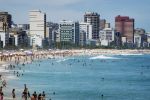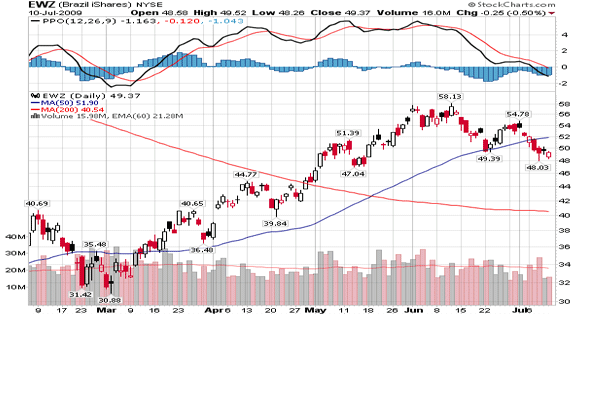 Brazilian stocks were once Wall Street darlings as the number of Brazilian ADRs traded on US exchanges started to increase in 2007. Thanks to investor interest in the so-called BRIC markets (Brazil, Russia, India and China) and a surge in commodity prices, Brazilian stocks gave investors tidy returns in the last bull market. The bubble for Brazilian equities burst in mid-2008 when commodities prices came back to earth. The global financial crisis sent Brazilian stock prices tumbling.
Brazilian stocks were once Wall Street darlings as the number of Brazilian ADRs traded on US exchanges started to increase in 2007. Thanks to investor interest in the so-called BRIC markets (Brazil, Russia, India and China) and a surge in commodity prices, Brazilian stocks gave investors tidy returns in the last bull market. The bubble for Brazilian equities burst in mid-2008 when commodities prices came back to earth. The global financial crisis sent Brazilian stock prices tumbling.
The market rally that started on March 9th has been kind to Brazilian stocks and the primary ETF that tracks them: the iShares MSCI Brazil Index (EWZ) (fund overview). EWZ is up more than 40% year-to-date compared to a very volatile but overall flat performance for the S&P 500.
Currently, about 27% of EWZ’s holdings lie in the basic materials sector. EWZ’s energy sector holdings are another 27%. Financial services names account for about 19% of the ETF’s holdings.
While Brazil has grown in recent years from emerging market to legitimate global economic power, many investors still regard the largest country in South America as a commodities play, particularly oil. To be sure, Brazil is one of the few countries that has recently made significant new crude oil discoveries. The country’s largest oil firm, Petrobras (PBR) is EWZ’s largest single holding at more than 24% (across two share classes). Another large commodity holding is mining giant Vale (VALE) at more than 14% (across two share classes) of the ETF’s holdings.
All of this would be fine if oil prices hadn’t topped out at $70 a barrel earlier this year and and then fallen back. China’s demand for steel and other commodities may also fall. Make sure you have an exit plan. Your plan could include selling your position in EWZ or buying put options. You might also consider hedging your exposure with the new ProShares UltraShort MSCI Brazil (BZQ) (fund overview) (article).
EWZ’s chart is showing signs of rolling over. After topping out at $58.13 intraday in mid-June, EWZ tumbled below $50 and made a lower high at $54.78 in late June. EWZ also recently pierced its 50-day moving average. Friday’s close of $49.37 signals that former support at $50 is just that: former support. While still firmly above its 200-day moving average, volume has been tapering off in EWZ. With the summer doldrums perhaps setting in on Wall Street, buyers may need more than the allure of the Brazilian market to become interested in EWZ in the near-term.
The other face of Brazil may not be familiar to most U.S. investors. Unlike the large-cap, commodity-export flavor of EWZ, Market Vectors Small Cap Brazil ETF (BRF) (fund overview) focuses on the internal growth of this vibrant country. As our recent article on BRF pointed out, it has a bigger weighting in consumer discretionary, financials, and utilities than EWZ. GVT Holding is the largest position in BRF at 5% while accounting for less than ½% weighting in EWZ.
As expected, BRF is performing much better in the commodity-oriented correction now underway. That gives investors one more choice for their EWZ exit plans outlined above – switching from EWZ into BRF.
